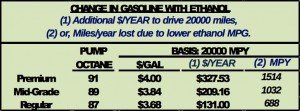You’re Getting Gassed by EPA Lies About Ethanol

EPA energy policy makers are unqualified and uninformed ideologues – who in their fervor to hasten environmental improvements are unnecessarily dictating that we waste our non-renewable energy to produce less non-renewable energy.
By Jack Beavers at Center for a Just Society
In his book The Seven Habits of Highly Effective People, Stephen Covey declared that “… all people see the world, not as it is, but as they are.”
I. F. Stone wrote, “All governments are run by liars and nothing they say should be believed.”
Every time you pull in to fill up with gasoline, you make a decision regarding what octane to purchase. Since the lower octane is priced lower, most consumers find the decision easy. But what if there is more information of which you are not privy? What if the sign stating “May Contain Up to 10% Ethanol” is posted as a disclaimer for something you don’t know – but if you did know, you wouldn’t like!
THE INTERNAL COMBUSTION ENGINE AND GASOLINE
“Educate and inform the whole mass of the people… They are the only sure reliance for the preservation of our liberty.” ~ Thomas Jefferson
In the 1920s, automobile engineers had known for a long time that both the power and the fuel economy of the gasoline engine are directly related to the pressure exerted on the fuel-air mixture in its cylinders at the peak of the compression stroke. In other words, they knew that a more powerful as well as more fuel efficient automobile could be made by simply building the engine so that the space above each piston was smaller at the peak of the compression stroke, e.g. higher compression ratio (CR).
However, an obstacle existed to building high compression ratio engines: the gasoline being burned. Gasoline becomes extremely violent if a fuel-air mixture is too highly compressed. Excessive pressure results in the auto-ignition of the fuel-air mixture before full compression and timed ignition (engine knock). The fuel starts burning before full compression requiring the cylinder to compress the already burning, expanding mixture. Thus in the early years, automobile engines had to be built with a compression ratio (CR) compatible with the auto-ignition point of the available gasoline.
Plato’s “necessity is the mother of invention” was proven when a company named Ethyl Gas developed a synthetic oil containing metallic ingredient Tetraethyl Lead (TEL) that, when added in very small amounts (3cc to a gallon of straight gasoline) eliminated its tendency to knock. In essence, the addition of TEL to gasoline raised the “Octane Number” and allowed gasoline to burn more efficiently in a higher CR engine. Thus began the pump octane distinctions of Regular (for the lower octane/CR engines) and Ethyl (for the higher octane/CR engines) – and the justification for the pump-octane price difference, e.g. the cost of TEL and the increase in fuel efficiency due to adding the “anti-knock” compound. (Author’s Note: it’s been determined that only 25%-30% of each gallon of gasoline contributes to the MPG. The rest of the gallon turns into heat and exits the vehicle via the cooling system or the exhaust.) The addition of TEL raised engine fuel efficiency (MPG) for the higher compression-ratio engines. However, burning high octane gasoline in a low compression-ratio engine was not found to result in higher MPG.
GOVERNMENT INTENTIONS
“My reading of history convinces me that most bad government results from too much government.” — Thomas Jefferson
In 1963, President Lyndon B. Johnson signed into law the Clean Air Act, a federal law designed to control air pollution on a national scale. It gave the Environmental Protection Agency its mandate to develop and enforce regulations to protect the public from airborne contaminants known to be hazardous to human health. Several amendments were subsequently added:
- Air Quality Act of 1967
- Clean Air Act Extension of 1970
- Clean Air Act Amendments of 1977
- Clean Air Act Amendments of 1990
The 1970 amendment greatly expanded the federal mandate requiring comprehensive federal and state regulations for automobiles. The regulations included banning the use of TEL in gasoline because of its neurotoxicity and damaging effect on catalytic converters. Following the ban on TEL, refiners utilized alternate, less effective anti-knock compounds, such as MNT, oxygenates (MTBE, TAME and ETBE). Methanol (wood alcohol) was also investigated but abandoned due to its affinity to water and the resulting potential engine damage and segregation-transportation costs. In addition, new processing technologies were brought on-line to make more high-octane components: reformate and alkylate.
The 1990 amendments mandated set gasoline reformulation requirements, set Reid vapor pressure (RVP) standards to control evaporative emissions from gasoline and mandated new gasoline formulations to be sold from May to September in many states. In compliance with EPA regulations, refiners produce hundreds of gasoline formulations (recipes) specific to locations and the sessional changes. In almost all locations, stations provided gasoline pump octane from 87 to 91 to accommodate engine compression ratios from 9:1 to 10:1, respectively.
THE EPA’s ENERGY POLICY
Saint Bernard of Clairvaux is credited for the proverb, “The road to hell is paved with good intentions” – which implies that good intentions, when acted upon, may have unforeseen bad consequences. Perhaps the best historical example involves the U.S. economic policies of the 1920s and 1930s. Intended to be a wise response to the economic turmoil following World War I and the Wall Street Crash, these are pointed to as the main reason for the Great Depression – and World War II.
The passage of the Energy Policy Act of 2005 marked a radical departure in the role of the EPA’s mandate to establish air quality regulations. This new legislation created the Renewable Fuels Standard (RFS) and gave the EPA unprecedented power to establish U.S. Energy Policy. For example, renewable fuels were defined by the legislation as fuels produced from renewable resources, i.e. biofuels (vegetable oil used as fuel, ethanol, methanol from biomass, and biodiesel) and hydrogen fuel (if produced with renewable processes). These fuels are presented as ideologically superior to natural gas, LPG (propane), petroleum, coal, shale oil, etc. and nuclear energy.
In 2007 the passage of the Energy Independent and Security Act of 2007 (EISA) gave the EPA expanded and extended power to make and enforce Energy Policy. Conceptually appealing, but based on ideology and misinformation, this legislation gave the EPA the power to force U.S. gasoline producers to use uneconomical and energy deficient “renewable fuel” components in their gasoline blending recipes. The EPA mandated that “grain alcohol a.k.a. ethanol” was the renewable automobile fuel – and that going forward, all US transportation fuels would contain a minimum volume of a “renewable fuel.” In fact, the RFS program required “renewable fuel” to be blended into transportation fuel in increasing amounts each year until the annual amount reaches 36 billion gallons by 2022.
ETHANOL
Dale Carnegie taught that to be successful in any endeavor, an individual had to have three distinct things, knowledge, skill and attitude. He pictured this as a triangle of success, with the sides designated as knowledge, skill and attitude. His example of a successful endeavor was learning to fly an airplane. First come the knowledge gained from ground school followed by the skill gained from student pilot training under the supervision of an instructor. Once knowledge and skill have been obtained, the proper attitude exists that allows the person to be a successful pilot. Mr. Carnegie was quick to point out that only attending ground school would not make a successful pilot, and that an attempt to pilot an airplane with only academic knowledge would result in catastrophic consequences.
“The most dangerous moment for a bad government is when it begins to reform.” — Alexis de Tocqueville
“Too many MBAs are arrogant and have a superiority complex. Some don’t live up to their potential because they skipped the rudimentary lessons gained from working with and managing people.” — Albert Dunlap
The Department of Energy (DOE) states that:
“Ethanol is an alcohol-based fuel made by fermenting and distilling starch crops, such as corn. It can also be made from “cellulosic biomass” such as trees and grasses. The use of ethanol can reduce our dependence upon foreign oil and reduce greenhouse gas emissions.” (Author’s Note: A bushel of shelled, sweet corn makes about 3 gallons of ethanol.)
In retrospect, ethanol has been around for thousands of years. This is the “grain alcohol or spirits” in the  world’s alcoholic beverages, i.e. beer, wine, whiskey, gin, vodka, etc. The concentration of ethanol in a given beverage depends on the beverage. Concentrations range from about 3.2% by volume in (beer) to 95.6% by volume in 190 Proof Everclear. Since 95.6% alcohol and 4.4% water form an azeotrope (meaning that simple distillation cannot remove any of the remaining water), 190-proof Everclear is the strongest ethanol available from the distilled beverage industry.
world’s alcoholic beverages, i.e. beer, wine, whiskey, gin, vodka, etc. The concentration of ethanol in a given beverage depends on the beverage. Concentrations range from about 3.2% by volume in (beer) to 95.6% by volume in 190 Proof Everclear. Since 95.6% alcohol and 4.4% water form an azeotrope (meaning that simple distillation cannot remove any of the remaining water), 190-proof Everclear is the strongest ethanol available from the distilled beverage industry.
Ethanol, as a motor fuel, has more desirable environmental properties and a high octane number (anti-knock resistance to auto-ignition) than straight gasoline. However, ethanol like methanol has a huge affinity for water and significantly less energy per gallon than straight gasoline, e.g. 76,000 BTU/Gal ethanol versus 115,000 BTU/Gallon in straight gasoline. This significant difference in energy resulted in the DOE issuing the advisory, “E10 (also called “gasohol”) is a blend of 10% ethanol and 90% gasoline sold in many parts of the country. All auto manufacturers approve the use of blends of 10% ethanol or less in their gasoline vehicles. However, vehicles will typically go 3–4% fewer miles per gallon on E10 than on straight gasoline.” With regard to the E85 future gasoline blends (85% ethanol, 15% gasoline), the DOE also advises, “FFVs (the new Flexible Fuel Vehicles) operating on E85 usually experience a 20-30% drop in MPG due to ethanol’s lower energy content.”
Most importantly, the decree that ethanol is a “renewable fuel source” is wrong! The renewable part is true—ethanol is a renewable food source (beer is historically referred to liquid bread) but the purity required for powering an internal combustion engine requires removing all the water remaining in the 190 Proof Everclear (the 4.4% that simple distillation cannot remove). To break the azeotrope and produce one gallon of acceptable 99.8% pure ethanol (suitable for blending with gasoline) requires an overall energy consumption in excess of 130000 BTU (more energy than in a gallon of straight gasoline). This results in a negative energy balance, e.g. 55000 BTU being consumed above the energy in the ethanol – and establishes that 99.8% ethanol is not a viable renewable fuel because to produce the fuel-grade ethanol, we are forced to “waste” unacceptable amounts of the world’s non-renewable energy (natural gas). Thus, when the non-renewable fuels are gone, the 99.8% ethanol will also be gone – except the EPA’s current mandate to make and use it actually brings us closer to the day when it will be no more.
Therefore, the consumer needs to know that (1) the pump-octane of a gallon of E-gasoline (E10, E15, and E85) will continue to be the same as the banned TEL blends – but (2) the energy in the E-gasoline will drop in proportion to the increase of ethanol in the blend – and this will result in a comparable loss in energy. So, while the gasoline implies it contains the energy in straight gasoline, the consumer will experience a loss of MPG. This loss in MPG means the E-gasoline has less value to the consumer. Which poses the question, are consumers still paying for the energy in straight gasoline while receiving the lower energy of the E-gasoline? If so, couldn’t this be argued as a “bait-and-switch” sales tactic?

“So enlisted, men may rightfully feel they are serving a function as high as that of any minister of the Gospel. They will not be Socialists, Communists, or Fascists, but plain men trying to gain by democratic methods the professed objectives of the Communists, Socialists, and Fascists…” (Henry Wallace, VP of US 1941-1945).
In December 2012, AAA advised:
“While E10 is approved for nearly all gasoline-powered vehicles, by law E15 can be used only by cars and light trucks from the 2001 model year and later, because it could have an adverse affect on the engines and emissions systems of older vehicles. According to the Renewable Fuels Association, 62 percent of the vehicles on the road today are cleared to use it, and regulations require pumps dispensing E15 to be clearly labeled with this information, but AAA thinks more needs to be done …. the sale and use of E15 should be suspended until additional gas pump labeling and consumer education efforts are implemented to mitigate problems for motorists and their vehicles,” adding that “consumers should carefully read pump labels and know their auto manufacturer’s recommendations to help prevent any problems from E15.”
In January 2013, The Associated Press reported on the EPA’s refusal to acknowledge their timetable for implementing “renewable Fuels” was unrealistic because the fuels were nonexistent:
“The [federal appeals] court recognized the absurdity of fining companies for failing to use a nonexistent biofuel,” said Bob Greco, director of downstream operations for the American Petroleum Institute, the principal lobbying group for the oil and gas industry….Greco said he was astonished that EPA would nearly double the mandate for biofuel in 2013. ‘EPA needs a serious reality check,’ he said, calling the mandate a ‘stealth tax on gasoline’ and an ‘egregious example of bad public policy.’ .…EPA spokeswoman Julia Valentine said the agency believes the proposed standards ‘are a reasonable representation of expected production” of biofuels this year.’
In March 2013, Hydrocarbon Processing Magazine reported:
“The price of credits used by refiners to meet federal ethanol blending requirements has risen more than 1,000% in recent weeks. The heightened volatility in this normally sleepy market has raised concerns that it is a factor in the recent rise in the price of gasoline.”
CONCLUSION
“There is no safety for honest men except by believing all possible evil of evil men.” –Edmund Burke, Reflections on the Revolution in France
 The original mandate of the EPA- to develop and enforce environmental regulations to protect the public – has been changed. The mandate now is to transform and enforce US Energy Policy to run on “renewable fuels”. While this would seem to be a noble goal, to ensure our environmental quality and abundance of energy, the EPA energy policy makers are unqualified and uninformed ideologues – who in their fervor to hasten environmental improvements are unnecessarily dictating that we waste our non-renewable energy to produce less non-renewable energy.
The original mandate of the EPA- to develop and enforce environmental regulations to protect the public – has been changed. The mandate now is to transform and enforce US Energy Policy to run on “renewable fuels”. While this would seem to be a noble goal, to ensure our environmental quality and abundance of energy, the EPA energy policy makers are unqualified and uninformed ideologues – who in their fervor to hasten environmental improvements are unnecessarily dictating that we waste our non-renewable energy to produce less non-renewable energy.
Ethanol is a renewable food source – it is not a renewable fuel source. The production of fuel-grade ethanol requires the consumption of energy well above what the product (ethanol) contains.
When ethanol is blended with straight gasoline, the result is a mixture with less energy – yet the consumer continues to pay for the missing energy based on the posted pump-octane. In most instances, this would be termed an illegal “bait and switch” tactic justifying legal action. However, the consumer is generally unaware of this change because the packaging (pump-octane) remains the same.
Ethanol is corrosive, difficult to handle and transport, and potentially detrimental to today’s engines, including automobiles, boats, ATVs and all small engines (mowers, trimmers, generators, tillers, etc.). Consumers must take special care with two-cycle engines due to warnings not to mix two-cycle oil with gasoline containing ethanol.
So what can we do? Unfortunately, change will not occur until we purge the ideologues from the federal government. Until then, we can only spread the word – while we continue to pay more for less, contend with the consequences of harmful good-intensions – and give thanks that the ideologues still let us drive our car.
“The more corrupt the state, the more it legislates.” – Tacitus
Jack T. Beavers is an Enterprise Risk Management (ERM) Consultant with a BS in Chemical Engineering (BSChE), a Professional Engineering (PE) license, a Certification in Business Management (CBM), and a Certification as an Internal Control Specialist (CICS). He has previously held a Certification as an ISO-9000 Internal Auditor – and his work history includes Enterprise Risk Assessment responsibilities as a Manager of Internal Audit. Please email your comments to forum@ajustsociety.org.
The CJS Forum seeks to promote an open exchange of ideas about the relationship between faith, culture, law and public policy. While all the articles are original and written especially for the CJS Forum, they do not necessarily reflect the views of the Center for a Just Society.
Also please consider:
Obama warned us he would make electricity rates ‘skyrocket’
Suicidal fuel – corn ethanol driving up world food prices in drought
Taxpayers subsidizing almost half of ethanol costs
Ethanol E15 scheme wreaking havoc on subsidies, food prices and the environment
Time to end the mother of all corporate welfare: ethanol subsidies
Ethanol and Corn: The Power of a Really Bad Idea
Bipartisan letter to congress opposing ethanol subsidies
Driving Under the Influence: Huge Taxpayer Investment in Ethanol Yields Paltry Payoff
EPA Funds Green Groups That Sue The Agency To Expand
“PC” power is not “sustainable”
Hunting for scapegoats won’t lower pump prices
American energy can jump-start US recovery but Obama blocks
Senators Supporting Ethanol Subsidies Reap Riches From Corn Interests
John Thune kills presidential hopes with ethanol deal
UN climate official admits climate hoax is about redistributing
Al Gore presidential aspirations cost US $16 billion in worthless ethanol subsidies and caused world’s poor to pay more for food
End Farm Subsidies
Close The Candy Store
Senators Supporting Ethanol Subsidies Reap Riches From Corn Interests
Help Make A Difference By Sharing These Articles On Facebook, Twitter And Elsewhere:
